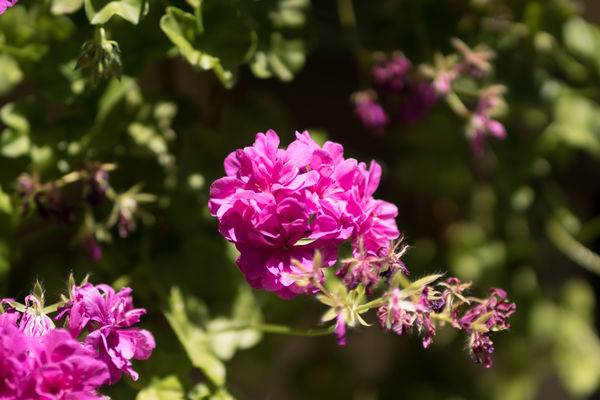Color "blooming" around bright colors
Jun 17, 2017 16:22:02 #
Today is the first time I've seen this color "blooming" or "glow" around bright colors. These are not areas with blinkies. Today was very humid, but the lens/camera had been out in the environment for at least half
an hour. Any ideas what's going on? Look around the orange and white shirts. This image was converted from RAW but had no editing done to it.
an hour. Any ideas what's going on? Look around the orange and white shirts. This image was converted from RAW but had no editing done to it.
Jun 17, 2017 16:32:11 #
dleebrick wrote:
Today was very humid, but the lens/camera had been out in the environment for at least half an hour. Any ideas what's going on? Look around the orange and white shirts. ...
One distinct possibility is a lens that is fogged from the humidity.
Jun 17, 2017 16:38:01 #
The key is in the manshorts! his left side is crisp in color, while there is flare on his right side and that flair extends in an eliptical area through the boy's shirt and hair up to the mother's right side of her shirt. If pictures taken since then don't have this effect, then it may have been moisture somewhere in the lens, otherwise, I suspect an oil on the lens - from your thumb, or cleaning the lens with a treated facial tissue. Little boys love to touch the lens of a camera just because..., well, just because.
Take a half capful of 90+ isopropyl and a q-tip. Dampen the Q-tip and use small circles that pass through the center of the lens and work your way all around the lens using no more than a few grams of pressure on the Q-tip.
Take a half capful of 90+ isopropyl and a q-tip. Dampen the Q-tip and use small circles that pass through the center of the lens and work your way all around the lens using no more than a few grams of pressure on the Q-tip.
Jun 17, 2017 16:41:07 #
Apaflo wrote:
One distinct possibility is a lens that is fogged from the humidity.
Or the kid had one hell of a dose of barium meal for breakfast!
Jun 17, 2017 16:51:25 #
Peterff wrote:
Or the kid had one hell of a dose of barium meal for breakfast!
Why Barium - he ain't even dead?
Jun 17, 2017 16:58:52 #
SS319 wrote:
Take a half capful of 90+ isopropyl and a q-tip. Dampen the Q-tip and use small circles that pass through the center of the lens and work your way all around the lens using no more than a few grams of pressure on the Q-tip.
DO NOT USE ISOPROPYL ALCOHOL.
It will dissolve the coating on the lens surface. Get a good lens cleaning fluid and use a tissues made for that purpose rather than a q-tip.
Jun 17, 2017 17:03:33 #
The sharpness is there....even the child's hair... I thought it was a hair by the lady but it is a chain on the fence. The blinkies may not have shown but you are at the top end of the exposure....and I would guess crosswise to the sun.
As was suggested you have grease (thumb print) on the lens...I find 'glasses' cleaning tissue and then a clean soft cotton cloth (clean handkerchief) works well.
As was suggested you have grease (thumb print) on the lens...I find 'glasses' cleaning tissue and then a clean soft cotton cloth (clean handkerchief) works well.
Jun 17, 2017 17:09:58 #
Kissel vonKeister
Loc: Georgia
dleebrick wrote:
Today is the first time I've seen this color "blooming" or "glow" around bright colors. These are not areas with blinkies. Today was very humid, but the lens/camera had been out in the environment for at least half
an hour. Any ideas what's going on? Look around the orange and white shirts. This image was converted from RAW but had no editing done to it.
an hour. Any ideas what's going on? Look around the orange and white shirts. This image was converted from RAW but had no editing done to it.
I'm guessing the camera was relatively cold compared to the ambient air and the humidity condensed on a lens surface - inside or outside the camera.
Jun 17, 2017 17:24:23 #
SS319 wrote:
Why Barium - he ain't even dead?
Better than radium!
Jun 17, 2017 17:48:43 #
dleebrick wrote:
Today is the first time I've seen this color "blooming" or "glow" around bright colors. These are not areas with blinkies. Today was very humid, but the lens/camera had been out in the environment for at least half
an hour. Any ideas what's going on? Look around the orange and white shirts. This image was converted from RAW but had no editing done to it.
an hour. Any ideas what's going on? Look around the orange and white shirts. This image was converted from RAW but had no editing done to it.
This is not fogging of the lens. And I am able to duplicate it.
From your EXIF data, I see you were shooting at 18mm and f6.3. But I couldn't determine what lens was used.
What you are seeing is called "Blooming". The pixels on a DSLR sensor collect photons, which are converted into an electrical charge. However, the pixels can occasionally collect too many photons, which causes an overflow of electrical charge. This overflow can spill onto existing pixels, causing overexposure in areas of an image. This is known as blooming.
I took a legacy Minolta 50mm f1.7 lens and took it out on a very sunny day today to show how to duplicate it. I will post a couple pictures below.
Image #1 : Here is a shot of a bright flower in direct sunlight taken at f.17. At this aperture, the area where things are in focus is very narrow and only tiny parts of the flower will be in focus. But look around the edges of the petals. There is blooming going on.
Image #2 : I stopped down to f4 and shot again. The focus depth has increased, and also the blooming has reduced a lot.
Some lenses are much more susceptible to blooming. I guess this must be a function of the lens coatings used, and older lenses are not as good as many newer lenses. In some cameras, there may be a means provided on the sensor to bleed off this extra charge so that it doesn't spill over onto adjacent pixels. And blooming is at its worst in areas of high contrast.
Image #3 : Changed lens and now am using a Tamron 15-30 f.28 lens. This shot is at f2.8.
Image $4 : Same Tamron lens, but now at f4
f1.7 image with lots of blooming
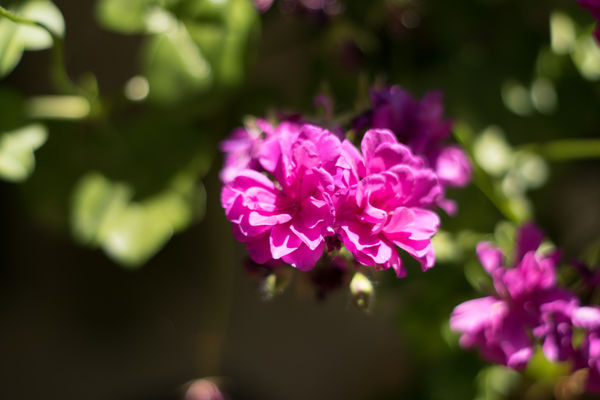
(Download)
f4 with less blooming
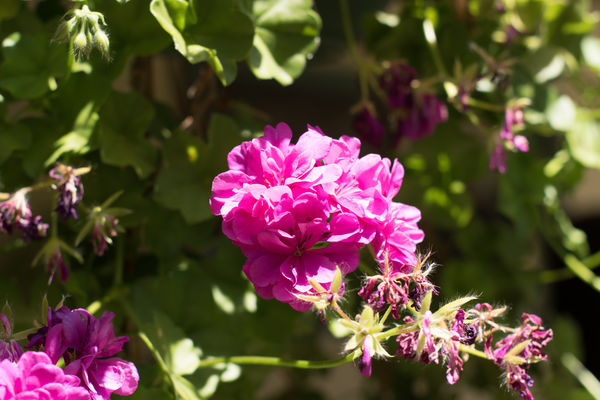
(Download)
Tamron 30mm f2.8
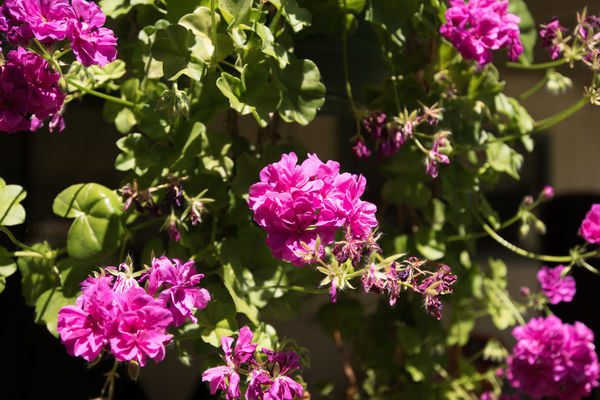
(Download)
Tamron 30mm f4.0
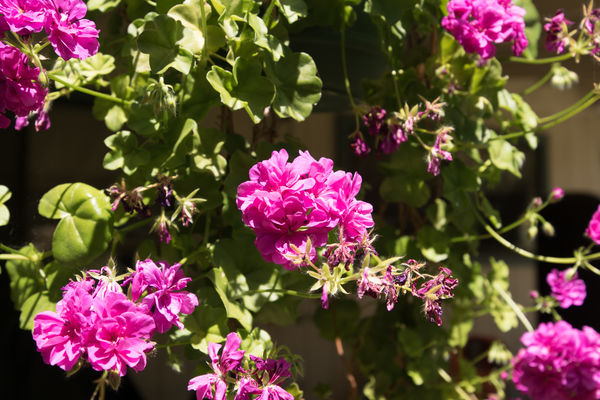
(Download)
Jun 17, 2017 18:08:21 #
JimH123 wrote:
This is not fogging of the lens. And I am able to duplicate it.
What you demonstrated is vastly different than either what the OP had or from what you described as blooming.
You showed the effects of Depth Of Field. You decribed a possible effect of over exposure. Neither of those exist in the OP's image. It also does not begin to look the same. The OP presented with a classic example of flare caused by moisture on part, but not all, of a lens element.
Jun 17, 2017 18:14:29 #
Apaflo wrote:
What you demonstrated is vastly different than either what the OP had or from what you described as blooming.
You showed the effects of Depth Of Field. You decribed a possible effect of over exposure. Neither of those exist in the OP's image. It also does not begin to look the same. The OP presented with a classic example of flare caused by moisture on part, but not all, of a lens element.
You showed the effects of Depth Of Field. You decribed a possible effect of over exposure. Neither of those exist in the OP's image. It also does not begin to look the same. The OP presented with a classic example of flare caused by moisture on part, but not all, of a lens element.
No, I don't think so. Forget the depth of field. Look at the edges of the petals in the f1.7 and see the blooming effect.
Now for comparison, here is a Samyang 50mm at f1.4.
This blooming effect is very much lens dependent and very much aperture dependent.
All pictures were taken within minutes of the others. The camera was set on Aperture priority at ISO 100 and only the f-stop was varied.
I have seen this effect with the Minolta 50mm f1.7 lens before and this is perhaps a 30 or 35 year old lens with old coatings. The Tamron and Samyang are modern lenses with modern coatings.
I can't tell what lens the OP was using other than it was at 18mm and f6.3.
Jun 17, 2017 18:26:53 #
Apaflo wrote:
What you demonstrated is vastly different than either what the OP had or from what you described as blooming.
You showed the effects of Depth Of Field. You decribed a possible effect of over exposure. Neither of those exist in the OP's image. It also does not begin to look the same. The OP presented with a classic example of flare caused by moisture on part, but not all, of a lens element.
You showed the effects of Depth Of Field. You decribed a possible effect of over exposure. Neither of those exist in the OP's image. It also does not begin to look the same. The OP presented with a classic example of flare caused by moisture on part, but not all, of a lens element.
One thing that could help determine the problem is if the OP took other images that day in differing lighting conditions and whether the blooming is always there or only in certain circumstances?
Jun 17, 2017 18:55:44 #
JimH123 wrote:
No, I don't think so. Forget the depth of field. Look at the edges of the petals in the f1.7 and see the blooming effect.
Now for comparison, here is a Samyang 50mm at f1.4.
This blooming effect is very much lens dependent and very much aperture dependent.
Now for comparison, here is a Samyang 50mm at f1.4.
This blooming effect is very much lens dependent and very much aperture dependent.
Yes different lenses show different flare, particularly lenses that are old and do not have modern anti-glare coatings.
But what you are showing does not look at all like the OP's image. Plus your images all have the red channel, but not green or blue, overexposed to the point of clipping. That is what is causing the flare in your images. The Minolta lens, being older, is worse.
The image posted by the OP is also right at the edge of clipping too, but it is equal across all channels, not just the red channel.
Your images have equal flare in all areas, the OP's image has flare in one particular area and is clear in other areas. That is very indicative of a partial obstruction on the lens. To see nearly the same effect, take a piece of tissue paper (Kleenex, a paper napkin, etc) and tear it so that it has a ragged edge. Put that across about 1/3rd of the the lens surface. Same effect. A more creative use is to just rip out a ragged round hole in the tissue, say about half the size of the lens diameter, and put the tissue in front of the lens. Nicely flared edges, with a sharp center if the hole is large enough... (Nice 'parlor trick' with tissue paper, but in the good ol' days people smeared a filter with petroleum jelly to get the same "soft portrait" flare effect.)
Jun 18, 2017 00:22:19 #
The blooming was not visible in all the shots taken at that time, but seemed to be more prevalent when there was high color contrast. I'll attach another image to show that. The blooming is way more than a few pixels, so I don't think it is related to focus. In this example, the area having the yellow flowers all has a yellow tint to it. This is the same image area as my prior image, so I'm giving credence to lens fogging in the high humidity we had today.
If you want to reply, then register here. Registration is free and your account is created instantly, so you can post right away.







